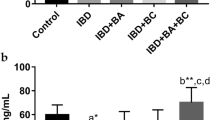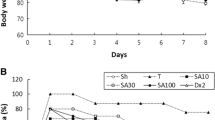Abstract
Purpose
To study the proinflammatory and anti-inflammatory cytokines present in the acute phase of trinitrobenzene sulfonic acid (TNBS)-induced experimental colitis treated with Saccharomyces boulardii.
Methods
Thirty male Wistar rats were divided into three groups: (1) treated group—received Saccharomyces boulardii for 14 days; (2) non-treated group—received sodium chloride solution for 14 days; (3) control group. Colitis was induced on the seventh day of the study in the treated and the non-treated groups using TNBS (10 mg) dissolved in 50% ethanol. Quantification of cytokines, including interleukin (IL)-1β (IL-1β), IL-6, transforming growth factor-β (TGF-β), IL-10 and tumor necrosis factor-α (TNF-α), in the serum and colonic tissue collected on day 14 were carried out using an enzyme-linked immunosorbent assay (ELISA).
Results
The mean concentrations of TGF-β in both the serum and the colonic tissue of the treated group were statistically higher than that of the control group. The mean concentration of TGF-β in the colonic tissue of the non-treated group was also statistically higher than the control group.
Conclusion
The group treated with Saccharomyces boulardii showed increased amounts of TGF-β, an anti-inflammatory cytokine, during the acute phase of colitis. There were no differences in the amount of TNF-α, IL-1β, IL-6, and IL-10 between the treated and the non-treated or the control groups during the acute phase of experimental colitis induced by TNBS.

Similar content being viewed by others
References
Elson CO, Sartor RB, Tennyson G, Riddel R. Experimental models of IBD. Gastroenterology. 1995;109:1344–1367.
Sartor RB. Review article: how relevant to human inflammatory bowel disease are current animal models of intestinal inflammation? Aliment Pharmacol Ther. 1997;11(S3):89–97.
Blumberg RS, Saubermann LJ, Strober W. Animal models of mucosal inflammation and their relation to human inflammatory bowel disease. Curr Opin Immunol. 1999;11:648–656.
Morris GP, Beck PL, Heridge MS, Depew WT, Szewczuk MR, Wallace JL. Hapten-induced models of chronic inflammation and ulceration in the rat colon. Gastroenterology. 1989;96:795–803.
Cabezas ME, Gálvez J, Lorente MD, et al. Dietary fiber down-regulates colonic tumor necrosis factor α and nitric oxide production in trinitrobenzenesulfonic acid-induced colitic rats. J Nutr. 2002;132:3263–3271.
Cherbut C, Michel C, Lecannu G. The prebiotic characteristics of fructooligosaccharides are necessary for reduction of TNBS-induced colitis in rats. J Nutr. 2003;133:21–27.
Peran L, Camuesco D, Comalada M, et al. Preventative effects of a probiotic, Lactobacillus salivarius ssp. Salivarius, in the TNBS model of rat colitis. World J Gastroenterol. 2005;11:5185–5192.
Surawicz CM, Elmer GW, Speelman P, McFarland LV, Chinn J, Van Belle G. Prevention of antibiotic-associated diarrhea by Saccharomyces boulardii: a prospective study. Gastroenterology. 1989;96:981–988.
McFarland LV, Surawicz CM, Greenberg RN, et al. Prevention of β-lactam-associated diarrhea by Saccharomyces boulardii compared with placebo. Am J Gastroenterol. 1995;90:439–448.
McFarland LV, Surawicz CM, Greenberg RN, et al. A randomized placebo-controlled trial of Saccharomyces boulardii in combination with standard antibiotics for Clostridium difficile disease. JAMA. 1994;271:1913–1918.
Surawicz CM, McFarland LV, Greenberg RN, et al. The search for a better treatment for recurrent Clostridium difficile disease: use of high-dose vancomycin combined with Saccharomyces boulardii. Clin Infect Dis. 2000;31:1012–1017.
Buts JP, Corthier G, Delmee M. Saccharomyces boulardii for Clostridium difficile-associated enteropathies in infants. J Pediatr Gastroenterol Nutr. 1993;16:419–425.
Kurugöl Z, Koturoglu G. Effects of Saccharomyces boulardii in children with acute diarrhea. Acta Paediatr. 2005;94:44–47.
Kollaritsch H, Holst H, Grobara P, Wiedermann G. Prevention of traveler’s diarrhea with Saccharomyces boulardii. Results of a placebo-controlled double-blind study. Fortschr Med. 1993;111:152–156.
Bléichner G, Blehaut H, Mentec H, Moyse D. Saccharomyces boulardii prevents diarrhea in critically ill tube-fed patients. A multicenter, randomized, double-blind placebo-controlled trial. Intensive Care Med. 1997;23:517–523.
Guslandi M, Mezzi G, Sorghi M, Testoni PA. Saccharomyces boulardii in maintenance treatment of Crohn’s disease. Dig Dis Sci. 2000;45:1462–1464.
Guslandi M, Giollo P, Testoni PA. A pilot trial of Saccharomyces boulardii in ulcerative colitis. Eur J Gastroenterol Hepatol. 2003;15:697–698.
Lee SK, Kim HJ, Chi SG, Kim YW. Saccharomyces boulardii ameliorates trinitrobenzenesulphonic acid-induced experimental colitis in rats: attenuation of pro-inflammatory gene expression. Gastrointest Endosc. 2006;63:AB 222.
Dalmasso G, Cottrez F, Imbert V, et al. Saccharomyces boulardii inhibits inflammatory bowel disease by trapping T cells in mesenteric lymph nodes. Gastroenterology. 2006;131:1812–1825.
Rogler G, Andus T. Cytokines in Inflammatory bowel disease. World J Surg. 1998;22:382–389.
Osman N, Adawi D, Adawi D, et al. Modulation of the effects of dextran sulfate sodium-induced acute colitis by the administration of different probiotic strains of Lactobacillus and Bifidobacterium. Dig Dis Sci. 2004;49:320–327.
Fuss IJ, Boirivant M, Lacy B, Strober W. The interrelated roles of TGF-β and IL-10 in the regulation of experimental colitis. J.Immunol. 2002;168:900–908.
Torres MI, Garcia-Martin M, Fernandez MI, Nieto N, Gil A, Rios A. Experimental colitis induced by trinitrobenzenesulfonic acid: an ultrastructural and histochemical study. Dig Dis Sci. 1999;44:2523–2529.
Lamine F, Eutamene H, Fioramonti J, Bueno L, Theodorou V. Colonic responses to Lactobacillus farciminis treatment in trinitrobenzene sulphonic acid-induced colitis in rats. Scand J Gastroenterol. 2004;39:1250–1258.
Foligné B, Nutten S, Steidler L, et al. Recommendations for improved use of the murine TNBS-induced colitis model in evaluating anti-inflammatory properties of lactic acid bacteria: technical and microbiological aspects. Dig Dis Sci. 2006;51:390–400.
Sugimoto K, Hanai H, Tozawa K, et al. Curcumin prevents and ameliorates trinitrobenzene sulfonic acid–induced colitis in mice. Gastroenterology. 2002;123:1912–1922.
Coeuret V, Gueguen M, Vernoux JP. Numbers and strains of lactobacilli in some probiotic products. Int J Food Microbiol. 2004;97:147–156.
Szajewska H, Setty M, Mrukowicz J, Guandalini S. Probiotics in gastrointestinal diseases in children: hard and not-so-hard evidence of efficacy. J Pediatr Gastroenterol Nutr. 2006;42:454–475.
Penna FJ, Filho LA, Calçado AC, Junior HR, Nicolli JR. Up-to-date clinical and experimental basis for the use of probiotics. J Pediatr (Rio J). 2000;76(Suppl 1):S209–S217.
Isolauri E, Kirjavainen PV, Salminen S. Probiotics: a role in the treatment of intestinal infection and inflammation? Gut. 2002;50(Suppl 3):III54–III59.
Neurath MF, Fuss I, Kelsall BL, Presky DH, Waegell W, Strober W. Experimental granulomatous colitis in mice is abrogated by induction of TGF-beta-mediated oral tolerance. J Exp Med. 1996;183:2605–2616.
Mulsow JJ, Watson RW, Fitzpatrick JM, O’Connell PR. Transforming growth factor-beta promotes pro-fibrotic behavior by serosal fibroblasts via PKC and ERK1/2 mitogen activated protein kinase cell signaling. Ann Surg. 2005;242:880–889.
Monteleone I, Pallone F, Monteleone G. Interleukin-23 and Th17 cells in the control of gut inflammation. Mediators Inflamm. 2009;2009:297645.
Author information
Authors and Affiliations
Corresponding author
Rights and permissions
About this article
Cite this article
Grijó, N.N., Borra, R.C. & Sdepanian, V.L. Proinflammatory and Anti-inflammatory Cytokines Present in the Acute Phase of Experimental Colitis Treated with Saccharomyces boulardii . Dig Dis Sci 55, 2498–2504 (2010). https://doi.org/10.1007/s10620-009-1072-1
Received:
Accepted:
Published:
Issue Date:
DOI: https://doi.org/10.1007/s10620-009-1072-1




